
Tourmalines
Tourmalines
Presentation :
Names) :
- Tourmaline => Buergerite, Schörl, Elbaite, Rossmanite, Feruvite, Uvite, Olenite, Liddicoatite, Foitite, Magnesiofoitite, Povondraite, Dravite, Chromdravite, Ferridravite, Vanadiumdravite, Tsilaisite.
Etymology:
- Tourmaline: From the Sinhalese tourmali which designated the crystals imported from Ceylon to Europe.
Group, Family:
- Tourmaline Group.
Color :
- Multicolor, Red, Orange, Dark Yellow, Yellow, Colorless, Apple Green, Light Green to Dark Green, Light Blue to Dark Blue, Blue-Mauve, Violet, Dark Magenta, Magenta, Red-Magenta, Brown, Black, sometimes Asterism or Shimmering, Rarely Changes color, Rarely Trapiche.
Chandelier:
- Glassy.
Origin :
- Brazil, Sri Lanka, United States, Madagascar, Tanzania, Zimbabwe, etc.
Crystal system:
- Trigonal 296.
Chemical composition :
- general formula: Na/xMg/yFeII/zFe/wAl/aLi/bCa/cCr/dTi/e [(OH)4|(BO3)3|Si6O18].
Transparency:
- Transparent, Translucent, Opaque.
Density :
- 2.84 to 3.40.
Hardness :
- 7 to 8.
Cleavage:
- Bad to Good.
Breakage:
- Irregular, slightly conchoidal.
Line color:
- White.
Shock resistance:
- Good.
Heat resistance:
- Good | May change color slightly around 450 to 650°C.
Black tourmaline with Quartz inclusion

black tourmaline
Black tourmaline properties:
- Black tourmaline is a basic stone in lithotherapy. This completely opaque black mineral anchors deeply to the earth and releases the grips of evil. The largest deposits are, as is often the case, in Brazil, but also in Madagascar. This stone is found in the form of a cluster or crystallized, in the latter form its surface is often covered with parallel lines.
Emotional and spiritual virtues:

black tourmaline
- A great anchoring stone, it helps to keep your feet on the ground, to be concrete, it reduces mental wandering, very useful when you are upside down. This tourmaline brings our energies down from top to bottom. It is used as a relief stone to rebalance during intense spiritual work, for example for a medium it allows you to cut the link and no longer be disturbed by entities. Black tourmaline also absorbs bad energies from people and places; it is not uncommon for the stone to crack or even “explode” into pieces upon contact with a large flow of bad energies. She will then have taken these energetic attacks for you, this degradation of the stone is reduced by using a larger stone and/or by purifying the black tourmaline more regularly.
Physical virtues:

black tourmaline
- This stone has properties influencing magnetic fields, it can be used to reduce the negative effects of electromagnetic waves from domestic electrical appliances. In people who are very sensitive to electromagnetic pollution, black tourmaline will greatly ease their lives. Black tourmaline helps urinate by energizing the renal system.
Purification and recharging:

Quartz sphere with black Tourmaline inclusions
- After a while the stone has given up all the energy it could, it can be energetically purified by immersing it for several hours in demineralized water. Black tourmaline can also be purified by placing it on a good quantity of salt. Charge the stone in the sun.

Black Tourmaline on Albite and Quartz
- By the term tourmaline, we often mean “black tourmaline” (also called Schörl ) but, as we will see here, tourmalines actually present a multitude of colors and varieties. Each has specific lithotherapy virtues associated with it…

The different colors of Tourmaline
Mineral characteristics of Tourmaline:

Difference in tones and colors of Tourmaline
- Tourmaline is the name given to a family from the group of borosilicates whose members, of complex and variable composition, share the same basic structure. Its wide range of colors (black, green, brown, yellow, red, pink, blue, yellow, colorless or multicolored), is explained by the different chemical elements that compose it: iron, manganese, nickel, cobalt, titanium, etc.
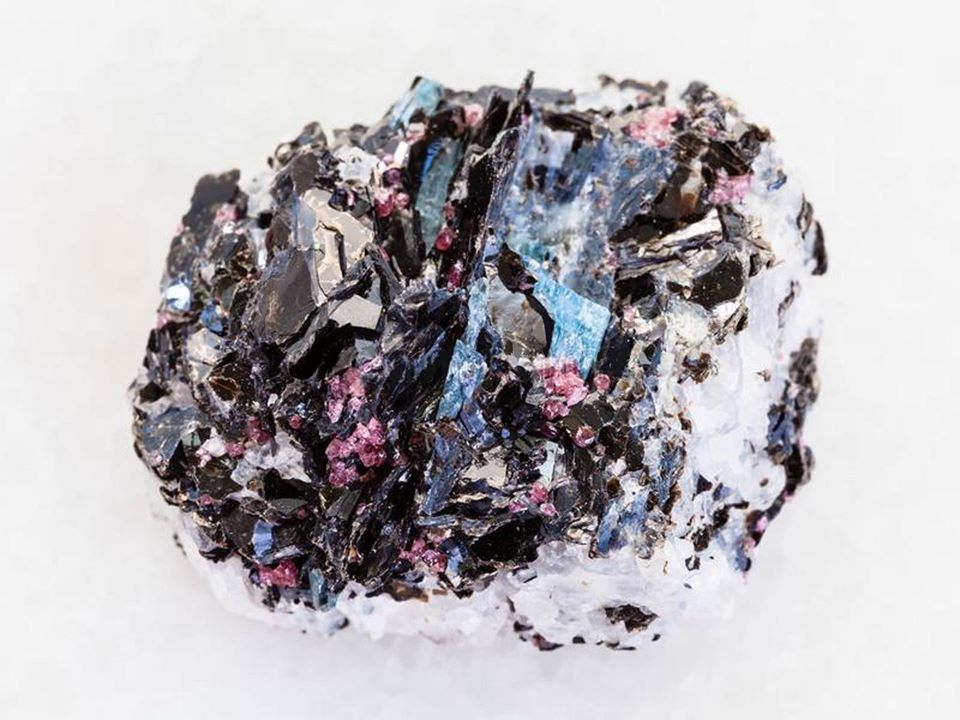
Gneiss, White Marble, Rubelite and Biotite
- Tourmaline is a fairly hard mineral: 7 to 7.5 on a scale of 10. These prismatic crystals with a triangular section are often vertically striated and have an acicular shape. They come mainly from pegmatites but also from gneisses and granite magmas. They are more rarely found in marbles. Tourmalines can also accumulate in alluvial deposits.

Green Tourmaline on Lepidolite
- Tourmaline is frequently observed in aggregation with other minerals: herderite, brazilianite, beryl, zircon, quartz and lepidolite. Black tourmaline with white spiky cleavelandite (a type of albite) is an example of a wonderful combination.
Varieties and colors of tourmalines:
Black Tourmaline on Quartz
There are several varieties of tourmaline. Their names are often assigned based on characteristics, places of origin or their color. Schörl is the most common black tourmaline. Its crystals, most often opaque, very rich in iron, can measure more than 2 m.
- Other known varieties include elbaite, dravite, liddicoatite, indigolite, achroite, siberite, rubellite and verdelite. Today, these names often give way to a simplified designation. We use the term “tourmaline” followed by its color, so verdelite becomes a “green tourmaline” like other species of green tourmalines. There are also tourmalines:
- Paraiba, very bright metallic blue-green tourmaline, color due to the copper which is part of its composition, a rare and very expensive stone from Paraiba in Brazil.
- Canary Tourmaline : yellow tourmaline, this tourmaline comes from the Canary mine in Zambia.
- Chrome tourmaline: very dark green tourmaline.
- Uvite: green to dark brown tourmaline, an uncommon tourmaline with a metallic appearance.
- There Buergerite: tourmaline in brown tones, a very rare stone coming exclusively from the town of Mexquitic in Mexico.
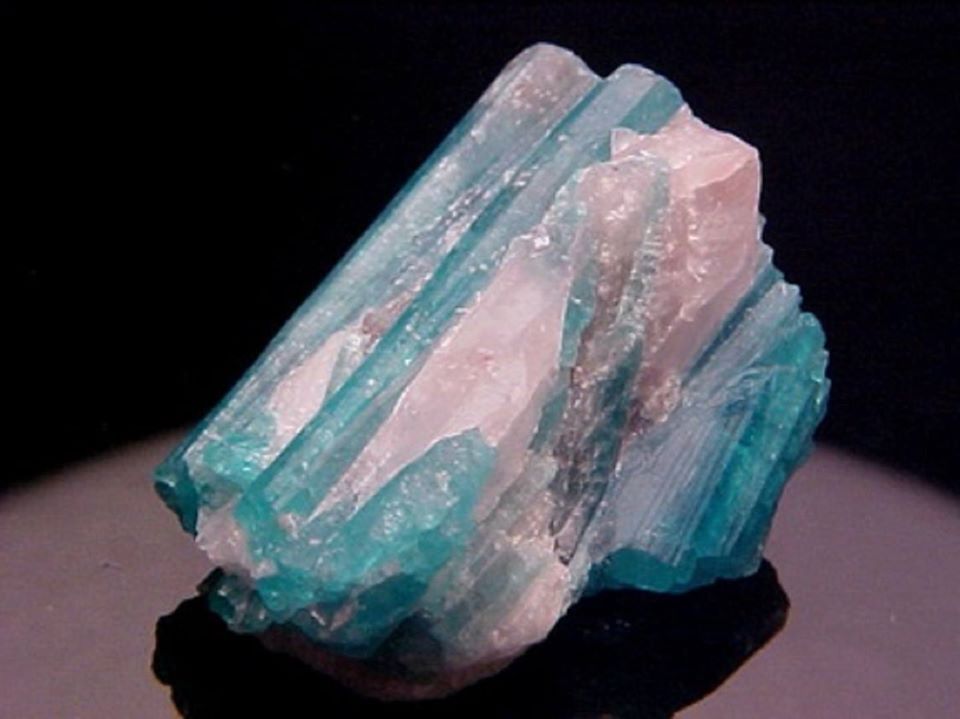
Paraiba blue tourmaline

Chromium tourmaline

Elbaite on Quartz

Canary tourmaline

Uvite - Red Tourmaline

Dravite - Brown Brown Tourmaline

Liddicoatite - Tourmaline

Indigolite - Blue Tourmaline

Verdelite - Green Tourmaline

Rubellite - Pink Tourmaline
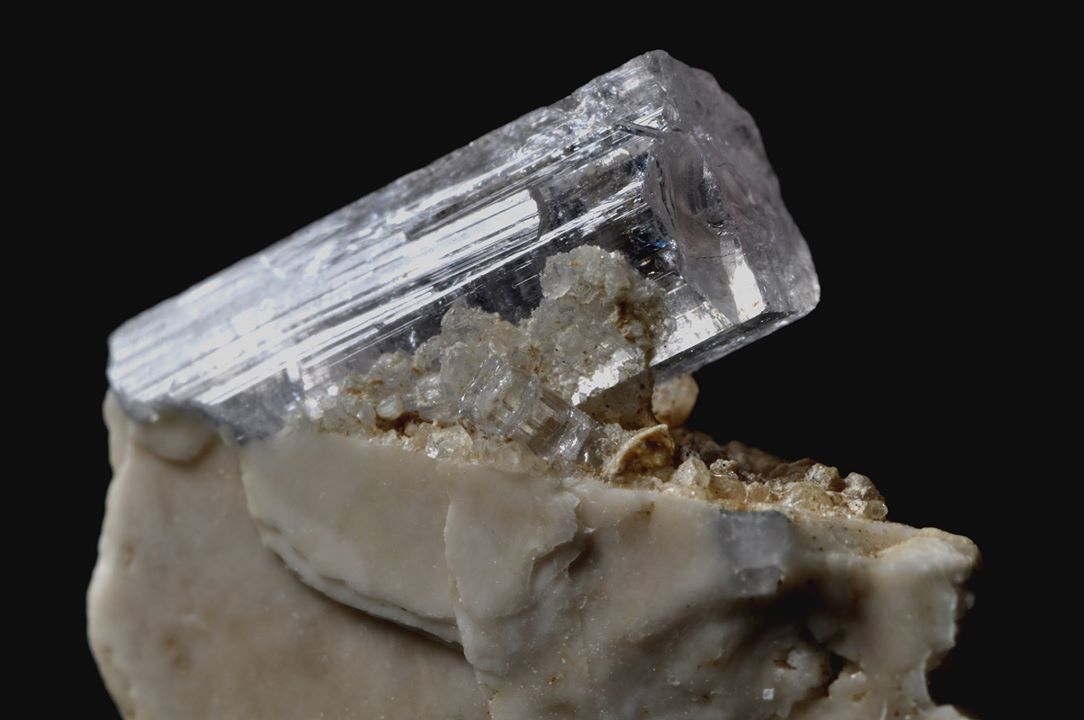
Achroite - Transparent Tourmaline on White Marble

Buergerite - Brown Tourmaline

Siberite - Purple Tourmaline
- Tourmaline rarely comes in a uniform color (apart from black), it usually comes in a variety of transparent shades.

Multicolor tourmaline

Tourmaline Turk's Head
- The color can also vary completely along the length of the crystal, in cross section or concentrically. Nature then composes sumptuous creations: green tourmaline with a red ending called “Turk’s head”

Moor's Head Tourmaline
- the colorless with black ending “Moorish head”.

Tourmaline Watermelon
The most spectacular is certainly pink or red tourmaline surrounded by green, it bears the pretty refreshing and vitaminized name of “watermelon tourmaline”.
- Pink, green or blue tourmalines, cut into cabochons, sometimes have a “cat’s eye” effect. Another particularity is observed in certain tourmalines: they are dichroic, their colors take on changing reflections in the light depending on the angle of view. This phenomenon, easily observed under artificial light, is also called the “Alexandrite effect”. Alexandrite being a stone from the chrysoberyl group which frankly presents this characteristic.

Alexandrite gem
- Heating between 450/600° or treatment with gamma rays modify the intensity of the colors but the results obtained by these artificial processes are unstable. The diversity of tourmaline colors explains the frequent confusion with many other minerals.
Electrical properties of tourmalines:
- The beauty of tourmalines is not their only asset. Their molecular structure produces pyroelectric (variation of electrical polarization driven by a change in temperature) and piezoelectric (electrical polarization under the action of a force) effects. These phenomena, increased in black tourmaline, have always been observed but their understanding will mobilize renowned scientists for a long time, including the physicists Jacques and Pierre Curie.
- Currently, industry uses tourmaline in pressure measuring systems for deep soundings (pressure gauges) and in the nuclear sector (protective concretes).
Properties and virtues:
- The electrical qualities of tourmaline give it a protective shield role. All tourmalines are affected but black tourmaline is particularly affected. Surrounding static electricity and harmful radio waves from electrical appliances, computers, and cell phones are absorbed. You can have them in several places in your home, near or on devices emitting these waves (television, computer, etc.).

Black Tourmaline On Quartz
- Also useful against the harmful zones of the Hartmann network, this electromagnetic grid which would cover the Earth. The properties attributed to tourmaline vary depending on the type of gem. Black tourmaline would be particularly effective, placed in the four corners of a house, to protect it from a geobiological point of view. It would strengthen the muscles, especially the heart.
- The “watermelon” version would be effective against emotional problems. Rubellite helps keep the liver healthy, it also protects the lymph and joints, not to mention the circulatory system. Blue tourmaline has beneficial effects on glands such as the thyroid, while green tourmaline concentrates its benefits on blood problems (anemia, poisoning).
- – prevention of cholesterol accumulation, – blood purification, – improved circulation, – improved sleep, – stress relief, – improved immune system…. etc,
- Tourmalines are minerals that produce negative ions
- To fully understand the benefits of negative ions, it is important to understand the effects that positive ions have on our body.
- The high concentration of positive ions (and the lack of negative ions) is associated with most environmental stressors found in our daily lives: pollution, cigarette smoke, pesticides, dust, waves emitted by high voltage lines, computers, mobile phones, electrical appliances etc.
- Positive ions create free radicals known to be dangerous to our health.
- Tourmaline converts humidity in the air into negative ions which neutralizes free radicals created by positive ions.

Different Tourmalines
General virtues of tourmalines (all colors):
Tourmalines, as a whole and independently of their colors, present common virtues and properties in lithotherapy.
- Protect the nervous and digestive systems
- Strengthen muscles, bones and teeth
- Help fight epilepsy
- Promote balance and coordination of movements
- Give self-confidence
- Alleviate fears
- Helps to understand others and oneself
- Inspire empathy and compassion
- Promote reconciliation
- Help achieve goals
- Promotes wealth and prosperity
- Facilitate commercial relations
- Help fight dyslexia
The colors of tourmaline and their rarity:
The immense variety of colors, tones and shades make it a highly sought-after stone, both for collectors and for jewelry.
We distinguish :
- Rubellitis: it is one of the rarest. Varies in the range of reds, being able to go from “ruby” red to “garnet” red to also take on pink or purplish shades.
- Indigolite: its color shades vary from intense blue to blue-green.
- Chromium tourmaline is also rare. Bright and crystalline green due to chromium and vanadium, it is preferentially found in East Africa.
- Paraíba tourmaline, named after the mine in Brazil, owes its incredible color to its copper content, ranging from Caribbean blue to turquoise blue to neon blue-green. It is probably the rarest and most expensive tourmaline.
- Black tourmaline or Schorl. Opaque crystal, it is the most common species.
- Two-tone tourmaline, which can combine any type of very distinct color in the structure of the stone. It is found more frequently in West Africa.
- The so-called “watermelon” tourmaline, a miracle of nature, rare, is found among other places in Brazil. Pink in the center, its color evolves towards green at the periphery passing through yellow.
But each variety of tourmaline has different properties, particularly depending on its color. Below, you will find the list of virtues of each type of tourmaline in lithotherapy.

Blue Tourmaline - Indigolite
Blue tourmaline (indigolite):
- Blue Tourmaline is part of the Tourmaline family. Their energy is dynamic and at the same time subtle. it activates stagnant energy or releases blocked energy.
- Blue Tourmaline is very suitable for releasing the mental energy of people who are too rigid or locked in their thought system.
- blue Tourmaline releases energy blocked in the mind; this stone is used for any tendency towards mental obsession which can go as far as neurosis; we are not talking here about clinical cases but about situations that we encounter every day. This energy thus released leaves room for intuition and creativity.
Properties and virtues:
- Strengthens the immune system
- Protects the respiratory system, throat and larynx
- Soothes burns and activates healing
- Promotes spiritual freedom
- Encourages tolerance and truth
- Dispel sadness
- Lift inhibitions
- Promotes inspiration
- Helps combat language disorders
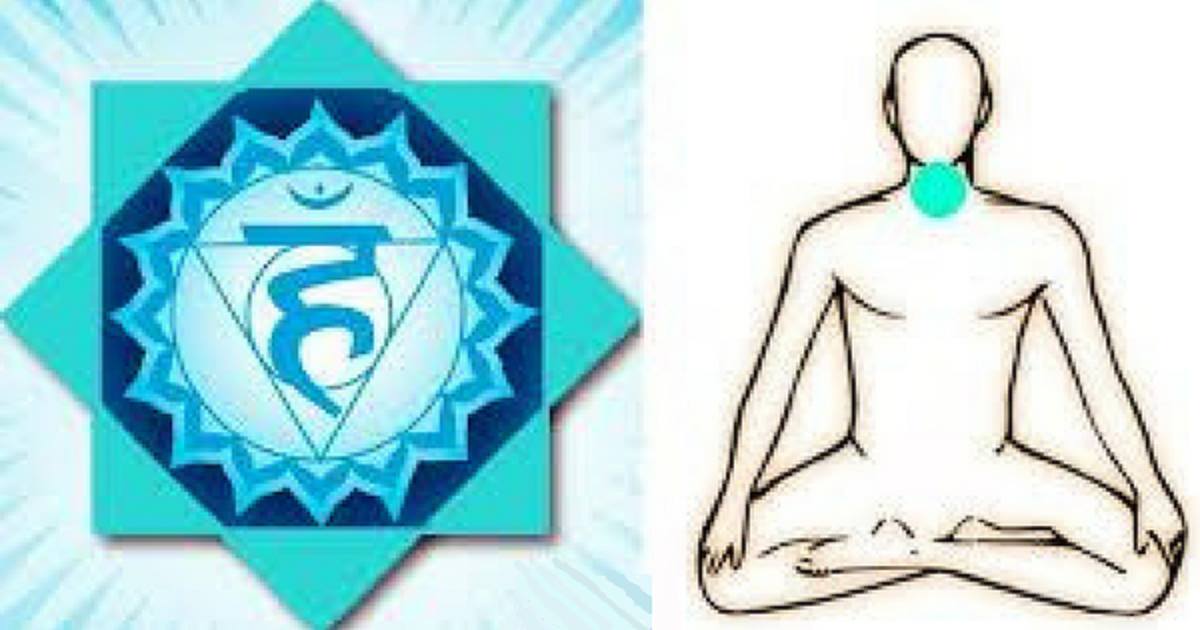
Throat chakra
_____________________

3rd eye chakra
__________________________________________________________

Brown tourmaline - Dravite
Brown tourmaline (dravite):
Properties and virtues:
- Calms dermatoses
- Relieves intestinal disorders
- Promotes relational ease
- Soothes difficult family relationships
- Helps to understand others and oneself

Root Chakra
__________________________________________________________
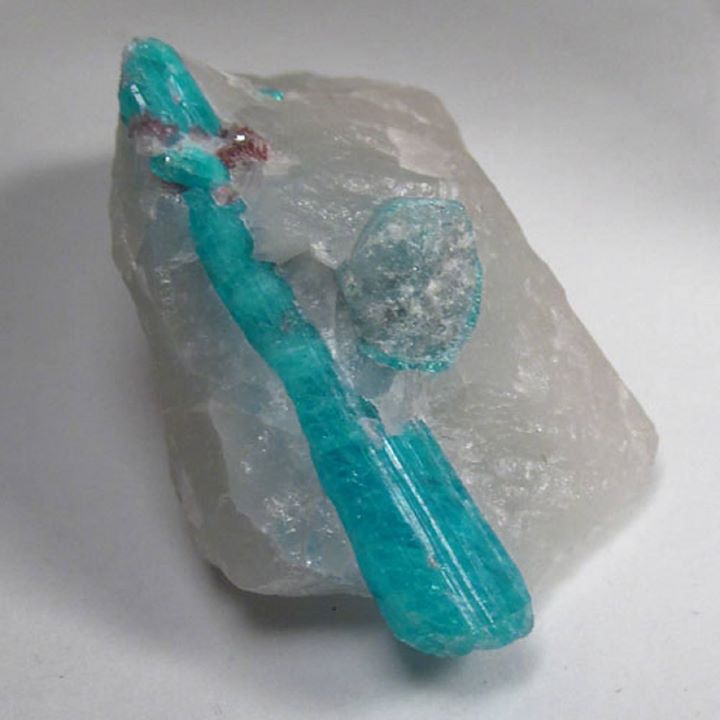
Paraiba blue tourmaline
Paraiba blue tourmaline:
Properties and virtues:
- Paraiba tourmaline helps to remove unsaid words, to make communication more fluid and to easily choose the most accurate and effective words in each situation.
- High vibration stone that brings harmony by illuminating the darkest situations.
- Encourages forgiveness by thus releasing the karmic past.
- It is a very powerful energy conduit.
- Stone of excellence for meditation because it attunes us to our higher self by also protecting our bio-magnetic envelope, aligning the chakras, the physical bodies, and the body of light.
- Sharpens intuition and develops clairvoyance.
- Replaces obsolete patterns, replacing them with the current patterns of the soul.
- Promotes forgiveness and letting go.
- Invites tolerance, thus freeing criticism and value judgments
- Soothes the mind and removes confusion, allowing better expression of thoughts and feelings.
- Greatly soothes fears and calms you during stressful situations.
- Helps you understand your emotional states and thus better interpret your feelings.
- Attenuates excessive reactions of the immune system and autoimmune diseases.
- Physically beneficial for:
- throat problems
- hay fever
- the teeth
- the stomach
- swollen glands
- thyroid problems
- metabolism and hormone production.

Throat chakra
__________________________________________________________

Yellow Tourmaline - Dravite
Yellow tourmaline (dravite):
Properties and virtues:
- Stimulates the solar plexus
- Favorable action on the stomach, liver, spleen, gallbladder, kidneys

Solar Plexus Chakra
__________________________________________________________

black tourmaline
Black tourmaline (Schörl):
Properties and virtues:
- Relieves arthritis and general pain
- Fight against pollution and all bad influences
- Helps the body eliminate heavy metals
- Relieves respiratory allergies (hay fever)
- Promotes the healing of skin diseases (shingles, erysipelas, etc.)
- Disperses nervous tension and stress
- Relieves anxiety and anxiety
- Increases vitality and energy
- Encourages a positive attitude
- Protects and absorbs electromagnetic waves

Root Chakra
__________________________________________________________

Pink tourmaline - Rubellite
Pink tourmaline (rubellite):
Properties and virtues:
- Relieves pre-menopause
- Calms dizziness and vertigo
- Promotes love and desire
- Inspire peace and wisdom
- Removes negative emotions and panic attacks
- Encourages growth

Heart Chakra or Master Heart
__________________________________________________________

Red tourmaline - Rubellite
Red tourmaline (rubellite):
Properties and virtues:
- Promotes good blood circulation
- Protects the venous system
- Harmonizes sexuality

Root Chakra
__________________________________________________________

Green tourmaline - Verdlite
Green tourmaline (verdelite):
Properties and virtues:
- Promotes good sleep
- Strengthens the immune system
- Help with weight loss diets
- Promotes good intestinal transit
- Protects vegetation (diseases and insects)
- Adjuvant for all remedies
- Helps particularly against epilepsy
- Encourages patience
- Calms hyperactivity, especially in children
- Predisposes to the joy of living
- Transmits patience

Heart Chakra or Master Heart
__________________________________________________________

Purple tourmaline - Siberite
Purple tourmaline (siberite):
Properties and virtues:
- Inspire tenderness
- Reduces depression
- Stimulates creativity
- Develops intuition

Crown Chakra
__________________________________________________________

Multicolored tourmaline - Elbaite
Multicolored tourmaline (elbaite):
Properties and virtues:
- Protects the immune system and metabolism
- Promotes dreams
- Stimulates imagination and the creative process
- Encourages all relationships

Sacral chakra
__________________________________________________________

Watermelon tourmaline
Watermelon tourmaline:
- Watermelon Tourmaline is a variety of Elbaite, which owes its name to the fact that its crystals are pink on the inside and green on the periphery. Although rare, this heartstone symbolizes the nature of Love that comes from within and radiates outward. It perfectly expresses the phenomenon of Love which is an energetic exchange between the inside and the outside: receiving and giving, giving and giving.
- In lithotherapy, Watermelon Tourmaline is very useful for anyone in a helping relationship: therapist, teacher, parent, caregiver, etc., so that they can be nourished in this relationship and flourish. It will help anyone find a balance between giving and receiving.
Properties and virtues:
- Virtues on the physical level:
- As it concerns the heart chakra, it soothes it, like all the muscles of the neck and neck. It also acts on the resorption of scars and calms the nervous system. It reduces the feeling of numbness, and relieves lumbago and other bodily tensions.
- Psychological, emotional and mental virtues:
- It helps fight effectively against depression, by absorbing the low energies of everyday life. Also, it makes its owners more compassionate, intuitive, charitable, while protecting them from turpitude and the evil eye.
- In short, this rock is indicated for untangling the complications of a tormented family, a couple in crisis, or for helping melancholic people to emerge from their isolation.
- Virtues on a spiritual level:
- Watermelon Tourmaline soothes the soul and increases self-confidence. It makes the qualities and life path of its owner more evident. Finally, happiness being more contagious than despair, it makes its owner more human and fraternal towards his neighbor.

Heart Chakra or Master Heart
Chakra and association:
- Tourmaline balances all the chakras but the most particularly associated chakra will depend on its color. Thus black tourmaline is associated with the root chakra just like red tourmaline (Rubellite) and brown tourmaline (Dravite) without forgetting brown tourmaline (Buergerite) nor red tourmaline (Uvite).

Root Chakra: Schörl Tourmaline (black) Dravite (brown) - Uvite (red) - Buergerite (brown) - Rubellite (red)
- Multicolored tourmaline (Elbaite) can be associated with the sacral chakra.

Sacral Chakra: Elbaite Tourmaline (multicolor)
- Yellow (Canary) at the solar plexus chakra.

Solar Plexus Chakra: Canary Tourmaline
- Pink tourmaline (Pink Rubellite) and watermelon as well as (Liddicoatite) at the heart chakra such as green tourmaline (verdelite) and chrome tourmaline.

Heart or master heart chakra: Watermelon tourmaline - Rubellite (pink) - Verdelite (green) - Liddicoatite (transparent green yellow red pink) - Chrome tourmaline (dark green)
- Blue tourmaline from Paraiba as well as blue tourmaline (Indigolite) at the throat chakra, as well as at the 3rd eye chakra for blue tourmaline Indigolite.

Throat chakra: Indigolite blue tourmaline - Paraiba blue tourmaline
- Finally, to finish, transparent and colorless tourmaline (Achroite) at the crown chakra just like purple tourmaline (Siberite).

Crown chakra: Achroite (transparent colorless) - Siberite (purple)

Tourmaline pencil
Tourmaline elixirs are recommended to combat addictions, fatigue, poor digestion and dizziness.
Purification and recharging of tourmaline:
- Tourmalines should be cleaned and purified frequently. Place them under running water from a faucet or in a glass or earthenware container filled with distilled or spring water. If you have the opportunity to immerse them in a river or in the water at the foot of a waterfall, then do it.
- It simply recharges in the rays of the sun (without excess) or the moon, or even on a quartz cluster.

Turk's Head Tourmaline Pencil and Quartz on Lepidolite
Tourmaline extraction locations:
- Tourmalines are present on all continents:
- Africa (Kenya, Madagascar, Malawi, Mozambique, Namibia, Nigeria, Tanzania, Zaire, Zambia, Zimbabwe).
- America (in the state of Minas Gerais in Brazil, California and Maine in the United States).
- Asia (Afghanistan, Burma, India, Nepal, Pakistan, Sri-Lanka).
- Oceania (Australia).
- Europe (Germany, Austria, Great Britain, Italy, Norway, Switzerland). In France, it is found in the Lyonnais, the Massif Central, the Massif des Maures, the Vosges, the Armorican Massif and the Pyrenees.
- The majority of tourmalines today come from Brazil. But, depending on the colors and varieties, these stones can come from Afghanistan (indicolites), India, Madagascar (rubellites), Sri Lanka, Tanzania, Burma, Russia (Siberites) or Thailand. We even find some crystals in France but they are not used in jewelry.













